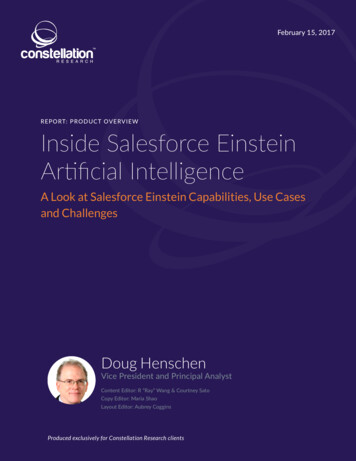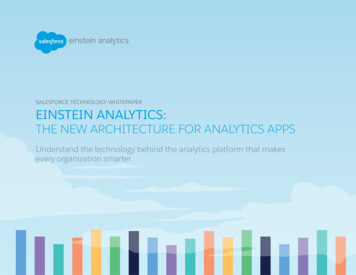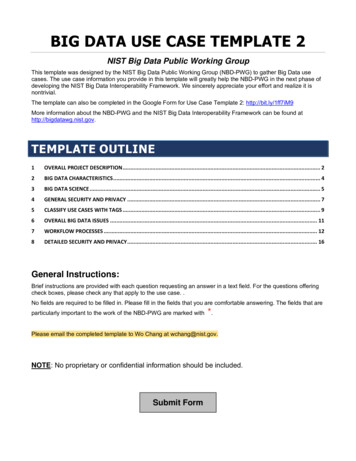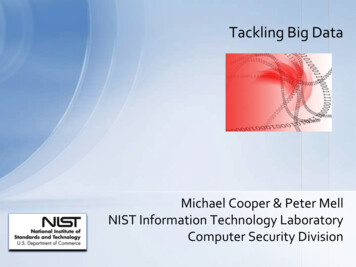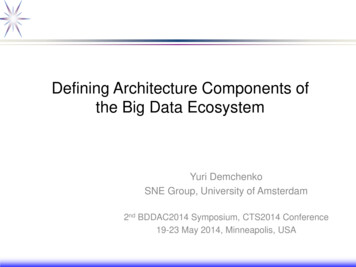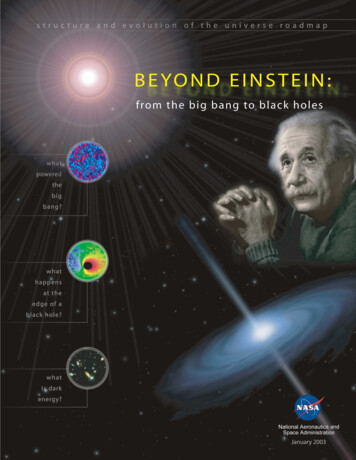
Transcription
prepared byThe Structure and Evolution of the UniverseRoadmap TeamJanuary 2003
Einstein images are used by permission of Roger Richman Agency representing Hebrew University and theAlbert Einstein estate. Image of Einstein riding bicycle (pg. 91) courtesy of the Archives, California Institute ofTechnology.Time magazine cover (pg. 21). Time is a trademark of AOL-Time-Warner, Inc., which has no connection to theNASA program.Photo of Richard Feynman (pg. 13) by Floyd Clark/Courtesy of Caltech Archives.Einstein letter to Georges Lemaître (pg. 13). Permission to quote granted by the Albert Einstein Archives, theHebrew University of Jerusalem, as well as by the Einstein Papers Project.2
PrefaceAt the beginning of time, the Universe was formless energy. This energy transformed intothe richly complex matter of which we and all we touch are made. The Structure andEvolution of the Universe (SEU) theme within NASA’s Office of Space Science seeks toexplore and understand the dynamic transformations of energy in the Universe—the entire web of biological and physical interactions that determine the evolution of our cosmichabitat. This search for understanding will enrich the human spirit and inspire a newgeneration of explorers, scientists, and engineers.This roadmap is about the future of the SEU theme. Many science objectives encompassed by the SEU theme have been given high priority by the science community throughworking groups, roadmap teams, and strategic planning processes. This roadmap drawsupon broad community input, including the specific recommendations of recent consensus reports of the National Academy of Sciences such as Astronomy and Astrophysics inthe New Millennium (2001) and Connecting Quarks with the Cosmos (2002).Many of the community’s science priorities could be realized within the next 25 years.This roadmap recognizes that, within the resources available, not all of these science objectives can be undertaken immediately. Constructing a roadmap clearly entails makinghard choices.In this roadmap, the science objectives for SEU are presented and prioritized. Theresearch programs and space missions required to address the science objectives are identified. The roadmap lays out a path that begins at the completion of the present programand leads to the future.The SEU theme’s highest priorities are presentedin the Beyond Einstein program (Part I). A roadmapis presented for realizing these objectives startingnow. The science objectives described in the Cyclesof Matter and Energy program (Part II) are presentedwith the understanding that this program will beundertaken after Beyond Einstein has begun. PartIII details continuing activities vital to maintainingthe technical base to implement these missions anddevelop future ones.3
Hubble Space Telescope image of the jet of plasma moving at relativisticspeed away from the supermassive black hole at the center of the nearby galaxyMessier 87.4
From the Big Bang to Black HolesHow did the Universe begin? Does time have a beginning and an end? Does space haveedges? Einstein’s theory of relativity replies to these ancient questions with three startlingpredictions: that the Universe is expanding from a Big Bang; that black holes so distortspace and time that time stops at their edges; and that a dark energy could be pullingspace apart, sending galaxies forever beyond the edge of the visible Universe. Observations confirm these remarkable predictions, the last finding only four years ago. YetEinstein’s legacy is incomplete. His theory raises—but cannot answer—three profoundquestions: What powered the Big Bang? What happens to space, time, and matter at the edge of a black hole? What is the mysterious dark energy pulling the Universe apart?The Beyond Einstein program aims to answer these questions. It will employ a seriesof missions linked by powerful new technologies and complementary approaches to sharedscience goals.Einstein Great Observatories: Facility-class missions Constellation-X: Uses X-ray-emitting atoms as clocks to follow matterfalling into black holes and to study the evolution of the Universe. The Laser Interferometer Space Antenna (LISA): Uses gravitational wavesto sense directly the changes in space and time around black holes and tomeasure the structure of the Universe.These missions are ready to pioneer technologies and approaches needed for theVision Missions to reach the ends of space and time.Einstein Probes: Fully competed, moderate-sized, scientist-led missions launched everythree years Dark Energy Probe: Determine the properties of the dark energy that dominates the Universe. Inflation Probe: Detect the imprints left by quantum effects and gravitational waves at the beginning of the Big Bang. Black Hole Probe: Take a census of black holes in the local Universe.These missions will answer sharply focused questions. Competition ensuresflexibility and keeps costs low by selecting methods and technologies.Programs of technology development and research in preparation for two “VisionMissions” reaching to the ends of space and time A Big Bang Observer to detect directly gravitational waves echoing fromthe earliest moments of the Big Bang. A Black Hole Imager to image directly matter near the edge of a blackhole and map its motion.Beyond Einstein fascinates the American public and compels the attention of the newsmedia and the entertainment industry. Beyond Einstein amplifies this fascination, developing an education component that enthralls students and is aligned with national standards. It will be a potent force with which to enhance science education and scienceliteracy.5
Hubble (top)and Chandra X-rayObservatory (bottom)images of the galaxyNGC 6240. The X-rayimage reveals lightfrom matter falling intotwo supermassiveblack holes (blue) inthe core of the galaxy.The two black holeswill merge in less thana billion years. TheBeyond Einstein LISAmission will measurethe ripples in spaceand time created bysuch events inother galaxies.6
ContentsPreface . 3From the Big Bang to Black Holes . 5Part I. Beyond Einstein . 9Beyond Einstein Science Objectives and Research Focus Areas. . 10Chapter 1. Executive Summary . 11The Beyond Einstein Program. 14Chapter 2. Scientific Goals and Missions. 21Beyond Einstein: The Science . 21Beyond Einstein: The Program. 31Beyond Einstein: The Missions . 35Chapter 3. Technology Roadmap: Beyond Einstein . 47Einstein Great Observatory Technologies . 47Technology Development for the Einstein Probes . 49Technologies for Beyond Einstein Vision Missions . 51Chapter 4. Research and Analysis . 55Theory . 55Supporting Ground-Based Research and Analysis . 56Chapter 5. Education and Public Outreach. 57Education, Outreach, and the Public Mandate . 57Part II. Cycles of Matter and Energy . 61Cycles Science Objectives and Research Focus Areas . 62Chapter 6. Science Objectives . 63A Rich and Diverse Universe . 63What We Have Learned . 65The Next Steps: The Space Astronomy Imperative . 66Chapter 7. Technology Roadmap: Cycles of Matter and Energy79Large, Lightweight Optics . 79Detectors . 79Spacecraft Systems . 81Part III. Supporting the Roadmap . 83Chapter 8. The Explorer Program. 857
Chapter 9. Research and Analysis . 87Experimental Research: Creating the Tools of Investigation . 87Theory, Observations, and Data Analysis:Reaping the Benefits of Investment . 89Chapter 10. External Factors . 91Last Word . 93Appendix A. Mapping of Science Objectives and Research FocusAreas to Investigations . 95Appendix B. Acronyms . 99Appendix C. Glossary of Terms . 101Appendix D. Sources of Further Information . 105Appendix E. Contributors to the Roadmap . 1078
Part IBeyond Einstein9
Beyond Einstein is a bold attack on the deepest mysteries of nature. The program will study the building blocks of our own existence at the most basiclevel: the matter, energy, space, and time that create the living Universe. Beyond Einstein missions will extend the reach of humanity to the ultimate extremes: the birth of the Universe, the edges of space and time near black holes,and the darkest spaces between the galaxies. Together these studies will helpus understand how the matter and energy of the Universe come to life.Beyond Einstein missions will connect humans to the vast Universe far beyondthe Solar System, to the entirety of creation. They will extend our senses beyond what we can imagine today: to the largest and smallest things, the beginnings and ends of time and space. The images and knowledge gained in thisquest will inspire all humanity—as only NASA can.Beyond Einstein Science Objectives and Research Focus Areas.NASA Agency Goal: Explore the Solar System and the Universe beyond.Science Objective 1. Find out what powered the Big Bang.Research Focus Area 1. Search for gravitational waves from inflationand phase transitions in the Big Bang.Research Focus Area 2. Determine the size, shape, age, and energycontent of the Universe.Science Objective 2. Observe how black holes manipulate space, time,and matter.Research Focus Area 3. Perform a census of black holes throughoutthe Universe.Research Focus Area 4. Determine how black holes are formed andhow they evolve.Research Focus Area 5. Test Einstein’s theory of gravity and mapspacetime near the event horizons of blackholes and throughout the Universe.Research Focus area 6. Observe stars and gas plunging intoblack holes.Science Objective 3. Identify the mysterious dark energy pulling theUniverse apart.Research Focus Area 2. Determine the size, shape, age, and energycontent of the Universe.Research Focus Area 7. Determine the cosmic evolution of thedark energy.10“Gravity is the forcethat rules theUniverse.To understand itsworkings,to the finest degree,is to understand thevery nature of ourcelestial home.”—M. Bartusiak inEinstein's UnfinishedSymphony
Chapter 1. Executive SummaryHow did the Universe begin? Does time have a beginning and an end? Does space haveedges? The questions are clear and simple. They are as old as human curiosity. But theanswers have always seemed beyond the reach of science. Until now.In their attempts to understand how space, time, and matter are connected, Einsteinand his successors made three predictions. First, space is expanding from a Big Bang;second, space and time can tie themselves into contorted knots called “black holes” wheretime actually comes to a halt; third, space itself contains some kind of energy that is pulling the Universe apart. Each of these three predictions seemed so fantastic when it wasmade that everyone, including Einstein himself, regarded them as unlikely. Incredibly, allthree have turned out to be true. Yet Einstein’s legacy is one of deep mystery, because histheory is silent on three questions raised by his fantastic predictions: (1) What powered theBig Bang? (2) What happens to space, time, and matter at the edge of a black hole? (3)What is the mysterious dark energy pulling the Universe apart?To find answers, we must venture beyond Einstein. The answers require new theories,such as the inflationary universe and new insights in high-energy particle theory. LikeEinstein’s theory, these make fantastic predictions that seem hard to believe: new unseendimensions and entire universes beyond our own. We must find facts to confront andguide these new theories. Powerful new technologies now make this possible.Here is where the Beyond Einstein story starts. By exploring the three questions thatare Einstein’s legacy, we begin the next revolution in understanding our Universe. Wechart our way forward using clues from observations and from new ideas connecting theworlds of the very small and the very large.What powered the Big Bang?During the last decade, sky maps of the radiation relic of the Big Bang—first by NASA’sCosmic Background Explorer (COBE) satellite and more recently by other experiments,including Antarctic balloon flights and NASA’s Microwave Anisotropy Probe (MAP)—have displayed the wrinkles imprinted on the Universe in its first moments. Gravity haspulled these wrinkles into the lumpy Universe of galaxies and planets we see today. YetThe MAP Explorermission provides theclearest view yet ofthe cosmic microwavebackground, using thewrinkles imprintedupon it from theearliest moments ofthe big bang toprovide precisionmeasurements on theexpansion andcontents of theUniverse.MAP SimulationSimulation of the map of the cosmic microwave background that is being obtained by NASA’sMicrowave Anisotropy Probe (MAP).11
Quantum fluctuations during the Big Bang are imprinted in gravitational waves, thecosmic microwave background, and in the structure of today’s Universe. Studying theBig Bang means detecting those imprints.still unanswered are the questions: why was the Universe so smooth before, and whatmade the tiny but all-important wrinkles in the first place?Einstein’s theories led to the Big Bang model, but they are silent on these questions aswell as the simplest: “What powered the Big Bang?” Modern theoretical ideas that try toanswer these questions predict that the wrinkles COBE discovered arose from two kindsof primordial particles: of the energy field that powered the Big Bang; and gravitons,fundamental particles of space and time.Measurements by missions of the Beyond Einstein program could separate these different contributions, allowing us to piece together the story of how time, space, and energy worked together to power the Big Bang.What happens to space, time, and matter at the edge of a black hole?The greatest extremes of gravity in the Universe today are the black holesformed at the centers of galaxies and by the collapse of stars. These invisiblebodies can be studied by examining matter swirling into them, and by listening to the waves of distortion they make in spacetime. New data from X-raysatellites, such as NASA’s Chandra X-ray Observatory and ESA’s XMM-Newton, show signs of gas whizzing about black holes at close to the speed of lightand hint that time is slowing as the gas plunges into the zone from whichMost of the X-ray sources seen in this 12-day exposure by the ChandraX-ray Observatory are active galaxies and quasars powered by massiveblack holes. Ground-based observations show that many of them areshrouded by dust; many others remain unidentified, invisible except inX-rays.12
Richard Feynman [Nobel Prize, 1965]showed that “empty” space was filled withvirtual particles.“In modern physics,the vacuum is simplythe lowest energy stateof the system. It neednot be empty noruninteresting, and itsenergy is not necessarily zero.”—From Quarks toCosmos,Report of theCommittee on thePhysics of theUniverseescape is impossible. Beyond Einstein missions willtake a census of black holes in the Universe and givedetailed pictures of what happens to space and timeat the edges of these roiling vortices.Beyond Einstein missions will listen to the soundsof spacetime carried by a new form of energy, predicted by Einstein, called gravitational waves. Wewill hear the booming, hissing, and humming of colliding and merging black holes and other extremeflows of matter throughout the Universe. Thesesounds will detail the conversion of matter and energy into warps in space and time. The measurements of gravitational waves will providea new way of understanding the behavior of space and time near black holes and take usbeyond to a new understanding of spacetime singularities.Einstein himself never dreamed that it would be possible to detect these waves, whichonly vary the distance between objects as far apart as the Earth and Moon by less than thewidth of an atom. Yet the technology now exists to do so.What is the mysterious dark energy pulling the Universe apart?A landmark discovery of the 1990s was that the expansion of the Universe is accelerating.The source of this mysterious force opposing gravity we call “dark energy.”Because he originally thought the Universe was static, Einstein conjectured that eventhe emptiest possible space, devoid of matter and radiation, might still have a dark energy,which he called a “Cosmological Constant.” When Edwin Hubble discovered the expansion of the Universe, Einstein rejected his own idea, calling it his greatest blunder.As Richard Feynman and others developed the quantum theory of matter,they realized that “empty space” was full of temporary (“virtual”) particlescontinually forming and destroying themselves. Physicists began to suspectthat indeed the vacuum ought to have a dark form of energy, but they could notpredict its magnitude.Through recent measurements of the expansion of the Universe, astronomers have discovered that Einstein’s “blunder” was not a blunder: some formof dark energy does indeed appear to dominate the total mass-energy contentof the Universe, and its weird repulsive gravity is pulling the Universe apart.“I found it very ugly indeed that the field law of gravitation should becomposed of two logically independent terms which are connected byaddition. About the justification of such feelings concerning logical simplicity it is difficult to argue. I cannot help to feel it strongly and I amunable to believe that such an ugly thing should be realized in nature.”—Albert Einstein, in a Sept. 26, 1947, letter to Georges Lemaître13
We still do not know whether or how the highly accelerated expansion in the earlyUniverse (inflation) and the current accelerated expansion (due to dark energy)are related.A Beyond Einstein mission will measure the expansion accurately enough to learnwhether this energy is a constant property of empty space (as Einstein conjectured), orwhether it shows signs of the richer structure that is possible in modern unified theories ofthe forces of nature.The Beyond Einstein ProgramThe Beyond Einstein program has three linked elements which advance science and technology towards two visions: to detect directly gravitational wave signals from the earliestpossible moments of the Big Bang, and to image the event horizon of a black hole. Thecentral element is a pair of Einstein Great Observatories, Constellation-X and LISA. Thesepowerful facilities will blaze new paths to the questions about black holes, the Big Bang,and dark energy. They will also address other central goals of contemporary astrophysics(discussed in Part II of this roadmap). The second element is a series of competitivelyselected Einstein probes, each focused on one of the science questions. The third elementis a program of technology development, theoretical studies, and education, to support theProbes and the vision missions: the Big Bang Observer and the Black Hole Imager. Theprogram offers competitive opportunities for mission leadership, technology development,and groundbreaking scientific research, with goals that excite the public.Einstein Great ObservatoriesWhile these two missions are focused on specific observational goals, the capabilities theyprovide are so dramatically new that they will also provide a broad science return that willimpact all areas of astrophysics, as have Hubble Space Telescope and the Chandra X-rayObservatory before them.The Laser Interferometer Space Antenna (LISA) will deploy three spacecraft orbiting the Sun, separated from each other by five million kilometers (17 light seconds).Each spacecraft will contain freely falling “proof masses” protected from all forces otherthan gravity. The relative motion of the masses can be measured to sub-nanometer accuracy by combining laser beams shining between the spacecraft. Passing gravitationalwaves will ripple space and time, revealing theirpresence by altering the motion of the proof masses.LISA will probe space and time at the formingedges of black holes by listening to the sounds ofvibrating spacetime: the booming roar ofsupermassive black holes merging, the chorus ofdeath cries from stars on close orbits around blackholes, and the ripping noise of zipping singularities.It may even hear whispers from the time in the earlyUniverse when our three-dimensional space formedwithin the now unseen space of six or seven dimensions. LISA will plot the orbits of stars aroundblack holes to test Einstein’s theory under extremeconditions.LISA measurements of merging black holeswill provide a new yardstick with which to meaLISA14
sure the Universe and constrain the nature of dark energy. LISA will also measure wavesfrom black holes in the first structures of the Universe to collapse. It will measure gravitational waves from thousands of binary star systems in our Galaxy, yielding newinsights into the formation and evolution of binary stars.The Constellation-X mission will consist of four 1.6-meter X-ray telescopes orbitingthe Earth/Sun system, providing nearly 100 times the sensitivity of the Chandra X-rayObservatory and other planned missions for X-ray spectroscopy. They will be instrumented to cover a range of more than a factor of 100 in X-ray energy with unprecedentedenergy resolution.Constellation-X will address the question, “What happens to matter at the edge of ablack hole?” When plasma streams collide at nearly the speed of light, they become hotenough to emit X rays. The vibrations of the X-ray light act as clocks that we can use totrack the motions of the plasma and the distortionsof space and time near the black hole. The greatsensitivity of Constellation-X will allow us to make“slow-motion movies” of the gas at a high framerate. Current instruments are not sensitive enoughfor the short exposures needed to freeze the motion.Constellation-X will dramatically increase ourability to obtain high resolution X-ray spectroscopyof faint X-ray sources. This will enable us to constrain the nature of dark matter and dark energy byobserving their effects on the formation of clustersof galaxies. These measurements, and those by theDark Energy Probe, LISA, and the Inflation Probe,will each constrain different possible properties ofdark energy and together lead to its understanding.Constellation-XConstellation-X’s high resolution spectra will provide fresh diagnostics of the speed, density, temperature, and composition of plasma in galaxies andexotic stars throughout the Universe, allowing new studies of their nature and evolution.Black holes grow both by accreting gas and by accreting stars. They change both byejecting gas and by merging with other black holes. To understand the origin and nature ofthe giant black holes in the centers of galaxies requires both LISA and Constellation-X,working together to cover all four of these processes.Einstein ProbesComplementing the facility-class Einstein Great Observatories, a series of sharply focused missions will address those critical science goals that do not require facility-classmissions. For these missions, the science question is defined strategically but the scienceapproach and mission concept will be determined through peer review. We identify threecompelling questions whose answers can take us beyond Einstein.“How did the Universe begin?” Scientists believe the Universe began with a periodof “inflation,” when the Universe expanded so rapidly that parts of it separated from otherparts faster than the speed of light. Inflation theory predicts that this expansion was propelled by a quantum-mechanical energy of the vacuum similar to the dark energy today. Itmay hold the answer to the question, “What powered the Big Bang?” One way to test this15
Many NASA missions have laid the groundwork for the Beyond Einstein program, and will complement it. NASA’s COBE discovered the first evidencefor primordial density fluctuations in the CMB. NASA’s balloon program (e.g.,the NASA/NSF/Italian/UK BOOMERanG) has supported the discovery of theinteraction of those fluctuations with matter in the Universe. NASA’s MAPsatellite and the ESA’s planned Planck satellite will extend these discoveriesand are vital precursors to the proposed Inflation Probe.The Hubble Space Telescope has helped to find and measure the distantsupernovae that have forced us to accept the reality of dark energy.X-ray missions, including NASA’s Chandra X-ray Observatory and RXTE,ESA’s XMM-Newton, and Japan’s ASCA, have discovered X rays from matterspiraling into black holes, illustrating the potential of Constellation-X.Gravity Probe B will test one of Einstein’s exotic predictions: that the rotation of the Earth drags space and time around the Earth into a mild version ofthe tremendous vortical spin near a spinning black hole.Swift will study gamma-ray bursts, believed to be a result of the stellarexplosions and mergers which create black holes. Swift will also test technology for the Black Hole Finder Probe.GLAST will provide more sensitivity and energy coverage than ever before for the study of high-energy emissions from particles accelerated in gammaray bursts and in the jets from spinning black holes in galactic nuclei.Japan/NASA’s Astro-E2 will be the first to use NASA-provided microcalorimeters that are prototypes for Constellation-X detectors.ST-7 and ESA’s SMART-2 will provide a flight comparison of two disturbance reduction technologies competing for use on LISA.idea is to look for relics of quantum fluctuations. Gravitational waves are the most directrelics since they penetrate the heat and density of those early days.It is technically feasible to look for the quantum effect of gravitational waves anddistinguish them from the quantum effects of the primordial energy, by examining theirdistinctive effects on the polarization of the cosmic microwave background. An “InflationProbe” with this capability will help define the nature of the vacuum that drove inflation.“How did black holes form and grow?” Most astronomers believe that the blackholes in the centers of galaxies grew by swallowing stars and gas, emitting light in theprocess. But there is an accounting problem: not enough light is coming from black holesin active galaxies to explain their growth. There are hints that much of the growth occurred behind a veil of dust. One way to see into these dark corners is to use the mostpenetrating of X rays. The “Black Hole Finder Probe” will perform a census of hiddenblack holes, revealing the demographics and life cycles of black holes and identifyingblack holes for study with Constellation-X. Combining these data with studies of accretion by Constellation-X and of black hole mergers by LISA will reveal how giant blackholes formed.“What is the mysterious energy pulling the Universe apart?” is a question that wouldnot have been asked five years ago, before there was evidence that the Universe was beingpulled apart. To understand this energy, we must measure the expansion of the Universewith high precision. This will require the most precise cosmic yardsticks we can find.16Gravitational wavesare vibrations in thefabric of space andtime. Gravitons aretheir quanta. Unlikephotons (the quanta oflight), gravitons hardlyinteract at all withmatter, so our senseshave never beforedetected them. Thelight we see from theBig Bang, theCosmic MicrowaveBackground, lastbounced off matterwhen the Universewas 300,000 yearsold. Gravitons fromthe Big Bang havebeen hurtling towardus unchanged sincethe Universe was 10-35seconds old!
The dark energy fillingyour house has justenough energy for aflea to make one jump.Yet across theimmense volume ofthe Universe, thisenergy can overcomethe gravitationalattraction of all thebillions of galaxies.Several ideas for such “Dark Energy Probes” have been proposed—for example, precision measurement of distant supernovae by a wide-field space telescope.Independent diagnostics of the dark energy will be crucial to verify the validity ofresults and to increase the precision of the measurements. The Inflation Probe and LISAwill provide completely independent cosmic yardsticks with which to measure the effectsof dark energy, and Constellation-X will observe the first clusters of galaxies whose evolution depends critically o
theory is silent on three questions raised by his fantastic predictions: (1) What powered the Big Bang? (2) What happens to space, time, and matter at the edge of a black hole? (3) What is the mysterious dark energy pulling the Universe apart? To find answers, we must v

